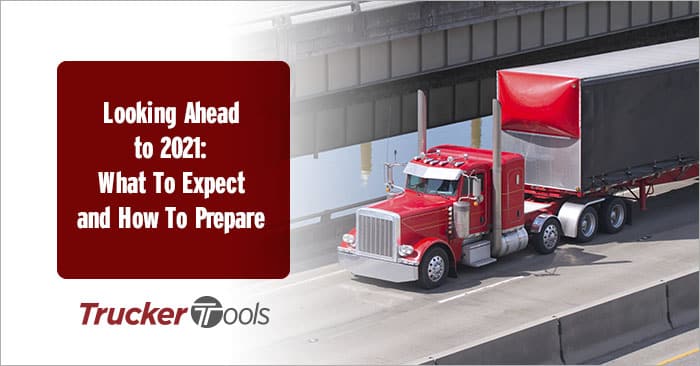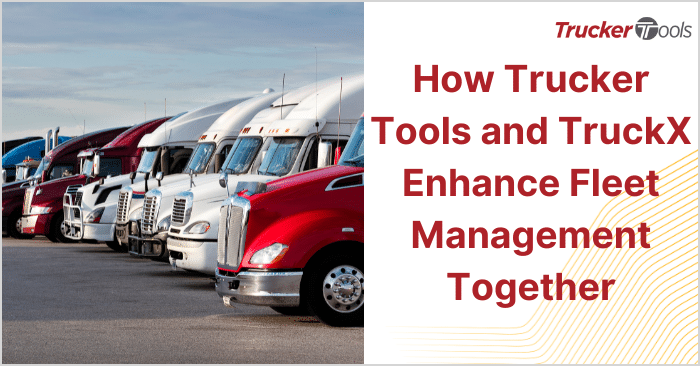Looking Ahead to 2021: What To Expect and How To Prepare

It’s been quite a year, one that most of us could not have predicted. Earlier this year, Trucker Tools hosted webinars with a panel of seasoned analyst experts to discuss the state of the transportation industry and what to expect in the future. We recently brought back our panel of experts to talk about key takeaways from 2020 and what to expect going forward in 2021.
In this most recent webinar, Peak Season and Beyond — What Path Will 2021 Take?, Prasad Gollapalli, founder and CEO of Trucker Tools, was joined by JOC’s Senior Editor Bill Cassidy, Contributing Editor at Logistics Management Magazine John Schulz and VP of Trucking at FTR Avery Vise. In this discussion, our team of industry experts discussed some of the challenges of Q3 and offered insights about peak season and the capacity crunch, as well as future challenges for the transportation industry.
The Challenges of Q3
The third quarter of 2020 brought us a huge spike in freight volume and a shortage of capacity driven by lack of drivers and available trucks. Unpredictability and unevenness in shippers’ supply chains has made planning and routing difficult for carriers because they don’t know which markets to go into. Uneven demand has stretched carriers thin, which has raised rates.
Service-based industries like restaurants, bars and movie theaters likely won’t recover until a COVID-19 vaccine is released, says Vise, who has been covering the transportation market for the last 35 years. Many other industries have completely recovered. One of the reasons that some industries have recovered is because there’s so much pressure to add products to retail inventories following a period of ultra-low inventories. Vise says this is what is generating pressure in the spot market, particularly in dry van.
Peak Season 2020
“This is the peak season to begin with in any sort of normal year,” said Schulz, who has been covering the trucking industry since 1982. “This has been a highly abnormal year. With inventory levels so low and replenishing ongoing, carriers can be very choosy about who they do business with. This year has made many throw their one year or even five year plans out the window. The carriers are simply taking it week by week. It’s a very unusual year.”
“This has been a highly abnormal year. With inventory levels so low and replenishing ongoing, carriers can be very choosy about who they do business with. This year has made many throw their one year or even five year plans out the window. The carriers are simply taking it week by week. It’s a very unusual year.”
According to Bill Cassidy, who has been working in the trucking industry for 30+ years, one of the biggest uncertainties for this year’s peak season is the availability of drivers. A number of drivers didn’t come back to work because of fears of COVID-19, which is still out there and shaking supply chains. Another factor that has impacted driver availability and capacity is the rise in short haul, e-commerce based freight.
“All the long haul truckload and LTL trucking companies are competing with short haul, e-commerce focused freight operations, whether they’re hauling from a warehouse to a local fulfillment center or doing final mile delivery,” says Cassidy. “People can get these jobs easily and they’re plentiful. They don’t need a CDL or to keep a logbook and they’re able to make decent money and stay at home. That’s an area that is going to become more and more of a competitor for the long haul freight haulers and that’s going to have an impact in 2021.”
What To Expect in 2021
Cassidy also advised that the economy is going to be uncertain going into 2021, but that there’s room for optimism. He expects that consumers will continue to buy more physical goods in 2021 than they did in 2019 prior to the pandemic, which has driven the economy’s rebound in Q3 and the fast growth in freight demand. Cassidy says he’s hearing from brokers, shippers and carriers in the past few weeks that we’ve hit peak and we’re not going to see a big drop off, but that we don’t know what’s going to happen with the Coronavirus overseas. He says we’re already seeing shutdowns of factories in Europe, which could make 2021 a lot like 2020.
As for Shulz, he thinks 2021 is going to be a very strong year for trucking, with one huge caveat: the effect of the Coronavirus. He feels all bets hinge on getting some kind of handle on COVID-19. If there are shutdowns, it will have a devastating ripple effect on trucking and the economy.
“If we do get a return to ‘normalcy,’ I see 2021 as more of a typical trucking year,” advised Shulz. “People in the industry are expecting volumes to dip in January and February and then to go back up. The auto industry and housing are poised to take advantage of some pent up demand. I’m fairly bullish about 2021. We can’t afford 100,000 Americans getting ill every day. It’s a huge caveat and a huge hedge, but I’m fairly optimistic about the economy and the trucking industry.”
Vise feels that the outlook for 2021 is quite good, though in some ways, the risks are even greater in 2021 than they were in 2020. One of the biggest risks is the Coronavirus. Another risk is that consumers may get maxed out on purchasing physical goods once we get passed the holidays. An additional factor to consider is what actions Congress takes with additional stimulus payments.
“Stimulus payments have driven some of that appetite for physical goods,” said Vise. “Now, that cash is being depleted and extra unemployment compensation is going away. There will be another stimulus at some point. I think by the time we get to January and February, we’ll be in a much more normal environment. Our base forecast is quite good for 2021.”
“Stimulus payments have driven some of that appetite for physical goods,” said Vise. “Now, that cash is being depleted and extra unemployment compensation is going away. There will be another stimulus at some point. I think by the time we get to January and February, we’ll be in a much more normal environment. Our base forecast is quite good for 2021.”
For the rest of the discussion, watch Peak Season and Beyond — What Path Will 2021 Take? Schedule a free demo of Trucker Tools’ digital freight matching and real-time visibility platform.





